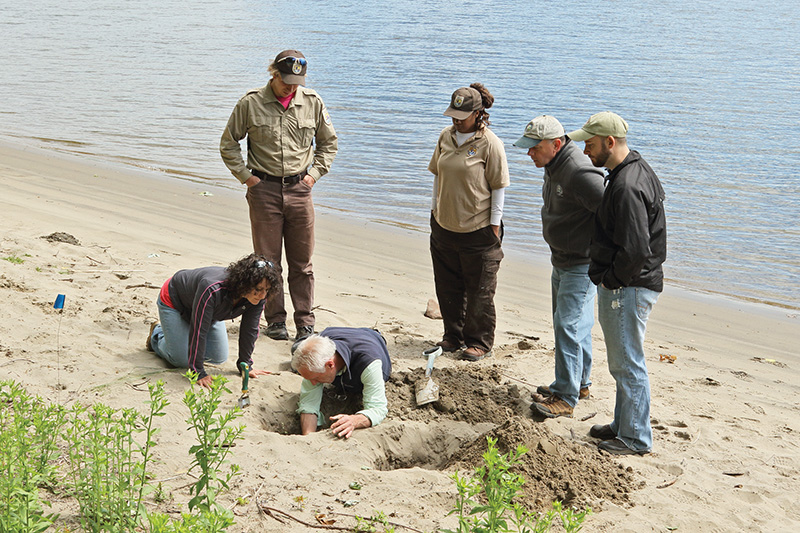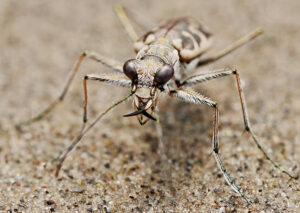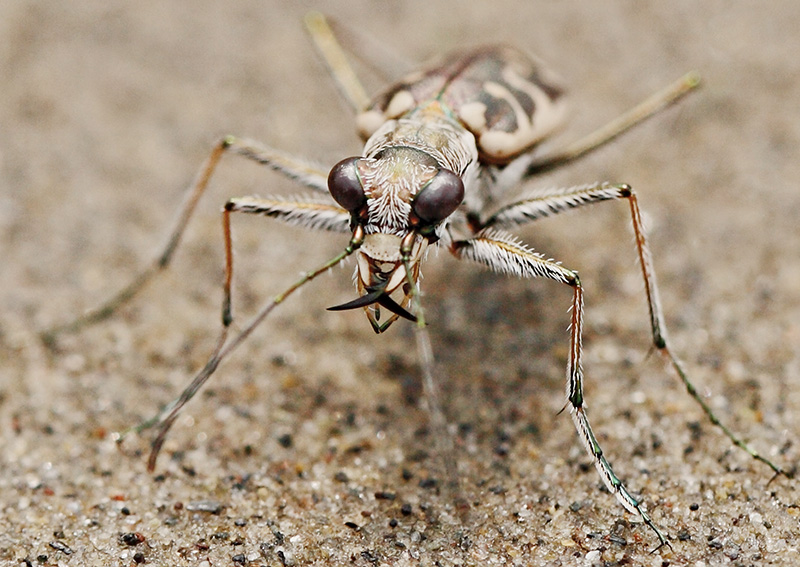 This article appears in the Summer 2024 issue
This article appears in the Summer 2024 issue

The Puritan Tiger Beetle
There are so many vantages from which to revel in the beauty of the Connecticut River and its tributaries. A view from the French King Bridge in Northfield, Massachusetts, provides a sweeping vista, while a quiet paddle on Whalebone Cove in Lyme, Connecticut, allows you to take in a gentle breeze as the pickerel weed sways. These views sustain us and enrich our lives. But this recurring column about less well-known or underappreciated river friends asks you to bring your vantage closer to the water and imagine the world from their perspective.
One of the many species of beetles that live in the Connecticut River watershed is the Puritan tiger beetle. That’s quite an incongruous mash-up of names! The Puritan tiger beetle is one of the many species of invertebrates (i.e., that have no backbone) that are threatened or endangered due to habitat loss, pesticide use, or climate change. These animals do not carry the same emotional or political weight as the many more well-known or charismatic vertebrate species under threat, but they are a critical part of a healthy river ecosystem nonetheless.

Biologists dug up larvae and transplanted them to two state-owned properties along the Connecticut River in Connecticut. Adult beetles were captured and brought to a lab created to rear and house the beetles at the Richard Cronin Aquatic Resource Center in Sunderland, MA. Image Credit: Paul Fusco, CT DEEP Wildlife Division.
This species of the tiger beetle family is known to live in only two locations 600 miles apart. Their home is in the Connecticut River valley and the Chesapeake Bay watershed on the sandy and wet margins of rivers and along eroding cliffs and bluffs.
Some have termed them vicious predators, but I prefer to think of them as exhibiting a unique foraging strategy. Like many insects, their different life stages have them behaving in very different ways. Both life stages require a healthy and naturally functioning river system to sustain them. In their first stage, the white larvae with a shovel-shaped head live inside elegantly constructed burrows designed to include a snug fitting hatch that they close during their two periods of overwintering. The larvae build these burrows within the wetted margins of sandy or silty riverbanks where the natural fluctuation of river levels throughout the year cover and uncover the burrows. The larvae are “sit and wait” predators that spend time at the entrance to their burrow capturing prey with their mandibles. To frustrate predators the larvae use a small hook on their body to anchor themselves in their burrow.

Only about as long as the width of your fingernail, the Puritan tiger beetle (Cicindela puritana) population is estimated at just over 500 beetles at two sites along the Connecticut River, one in Massachusetts and the other in Connecticut. Image Credit: Paul Fusco, CT DEEP Wildlife Division.
After two seasons, the adults emerge in early summer with pincer-like mandibles and highly acute vision to become active predators, imitating the hunting behavior of the tiger. It is difficult to see the highly camouflaged adults, but close inspection will reveal their patient stillness punctuated by rapid bursts of motion during which their mandibles capture flies, ants, and other small insects. I’ve only ever seen a more common species of tiger beetle, but watching them hunt on a warm, early summer day on a sandy beach in the Maidstone, Vermont, stretch of the Connecticut River affirmed for me their tigerlike hunting prowess.
These creatures are among those plants and animals that have adapted to dynamic environments that are regularly disturbed. Riverbanks are constantly forming and reforming due to the movement of sediment, the scour of ice, and the up-and-down height of rivers. These natural disturbances create and maintain sandy, silty beaches with sparse vegetation. When banks are stabilized, they can become heavily vegetated, which eliminates hunting habitat for the adults. And like us, tiger beetles like warm, sandy beaches that occur along the bends of rivers. As we land our boats or have our picnics at these beaches we can destroy the burrows. Because the operation of hydropower dams can significantly impact water levels, when these projects come up for a renewed license the plight of the Puritan tiger beetle is among the many considerations for how to balance the generation of energy and supporting a healthy river.
The Puritan tiger beetle is listed as either threatened or endangered throughout the Connecticut River watershed for reasons that include habitat loss. Today there are only two locations within the watershed (identifying the exact location is discouraged by wildlife folks) that support the Puritan tiger beetle, thereby putting their population at risk. But there are continuing efforts to help these critters to hang on, including a short-term hatchery program supported by committed researchers and the United States Fish and Wildlife Service, the state wildlife agencies in Massachusetts and Connecticut, and the University of Massachusetts.
The dedicated care of Drs. Rodger Gwiazdowski, Joe Elkington, and Laura Saucier launched a unique effort to capture adult Puritan tiger beetles and, through careful trial and error, rear over 450 larvae in a converted federal salmon hatchery in 2017 and 2018. The larvae were released along a stretch of sandy beach to give these struggling apex predators of the insect world a helping hand. While this was only a one-time effort, it is worth celebrating how a passion for wildlife of all kinds, determination and ingenuity, and an optimistic spirit show that we can strive to protect and restore a healthy environment.
Andrew Fisk, PhD, is the Northeast Regional Director for American Rivers. American Rivers is championing a national effort to protect and restore all rivers, from remote mountain streams to urban waterways. Healthy rivers provide people and nature with clean, abundant water and natural habitat. For fifty years, American Rivers’ staff, supporters, and partners have shared a common belief: Life Depends on Rivers.

